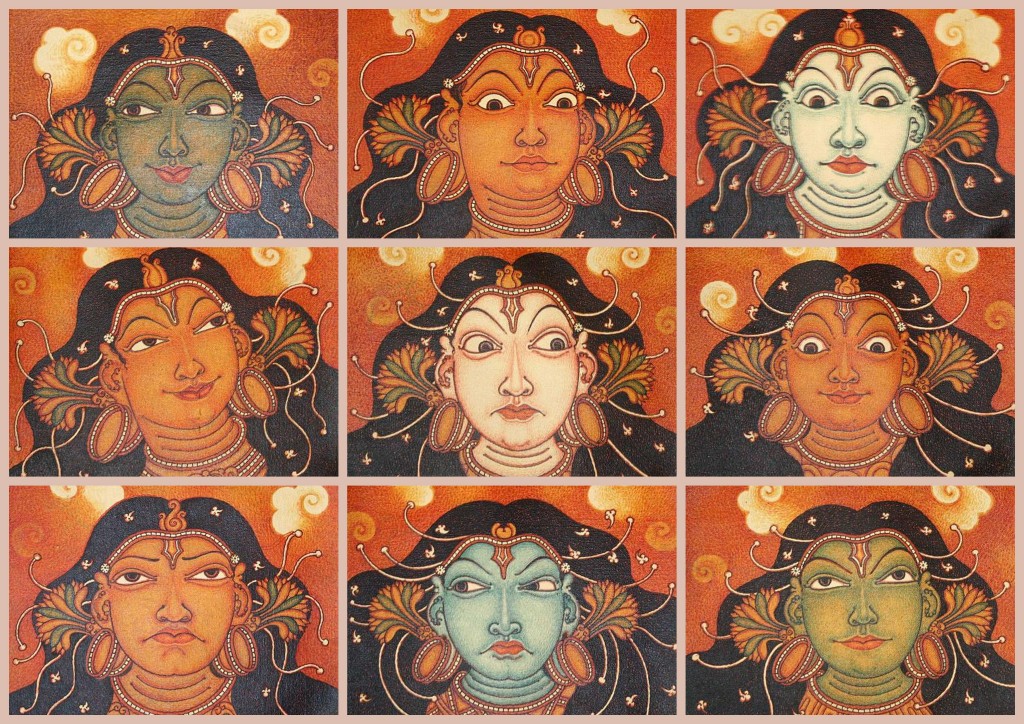Vandana Shukla
Laughter comes as naturally to humans, as does anger or pathos. All human expressions have occasional humorous anecdotes; to kill monotony.
In art, though humour is inexplicable. It can be decipherable; subject to perceptibility.
Long before Indian art acquired the stiff- upper- lip stance of modernism; it was already defined by the principles of the nine rasas. The nine rasas are a spectrum of human emotions that outline the aesthetics of Indian art. According to Bharat Muni’s Natyashastra these nine rasas are; erotic, comic, pathetic, furious, heroic, terrible, odious, marvelous and quietist.

Courtsey- Krishnakshi Kashyap
Hasya or humour has been used as an integral rasa to complete the spectrum of human expression since the first lines were sketched in a cave by the primitive man.
All genres of art incorporated humour.
I witnessed the oldest expression of humour in plastic art dating back to 2300 BCE, at Peshawar Museum, in Pakistan. Found in Mohenjo-Daro excavations; a cluster of clay figurines show all the possible facial expressions humans have. These moulds include a few quirky faces too, to arouse amusement and laughter. About 2300 BCE, people observed what could be humorous and found a way to express it.
From Lascaux caves of France to Bhimbetka of Bhopal, cave paintings show that the sense of humour of the primitive man was no different from that of the man of the 21st century.
With time, the forms and contents change; finding newer ways to express the underlying emotion of hasya. If TikTok defines what is humorous in the 21st century digital era, Paleolithic and Mesolithic period art had humour of its own kind. A kind of mocking of the human will against the might of the animal world.
A 2018 report of a geologist from New Mexico refers to a series of fossilised footprints found in New Mexico. They are the prints of a giant sloth, with much smaller human footprints inside them. Suggesting, that the humans were deliberately matching the sloth’s strides; following it from a close distance. Or, were they mocking it?
Life, as it was, found expression in the raw cave paintings and clay moulds in the ancient times. In the cave paintings of Bhimetka, which has layers of paintings; painted at different points in time; several facets of human and animal life are drawn with a chuckle. Women digging out rats from the holes, an elephant painted within the outline of a deer, suggest, a humorous approach of humans to their surroundings. In one of the paintings, a horned boar of enormous size, with fur on the head is chasing a tiny human figure and a crab. The human figure and the crab are fleeing the giant horned boar. The technique of juxtaposing the human with a crab is brilliant; it is used in caricatures to create humour even today.
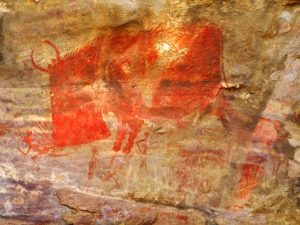
Courtesy- Wiki Commons
One finds many amusing illustrations from Jataka tales, that deals with the previous lives of the Buddha. In one of the illustrations from the Jataka in Bharhut sculptures in Madhya Pradesh, of the Sunga period, dating back to mid-2nd century BCE, a monkey is shown extracting a hair from a man’s nose. The hair is held by a pile which is pulled by an elephant. The elephant seems to have found the job strenuous. Therefore, the monkeys seem to encourage him by playing the trumpets and drums. One monkey is seen even striking the elephant with a stick, another is biting his ear. The whole illustration is conceptualised following the Indian tradition of using the animals allegorically; to give a profound message. Here, perhaps the message follows the adage of digging a mountain to find a rat.
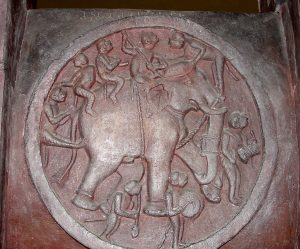
In another roundel on a balustrade, a group of monkeys is shown taking out an elephant, in a procession. These sculptures reflect the peculiarities of the times with an element of humour directed at the social oddities; an elephant being driven by the monkeys. Perhaps ridiculing the power game run by mediocrity.
Even though the expression of humour in art is time and culture specific; it carries a certain universality. Therein lies its timeless appeal.
The comical element was often depicted using the motif of animals. In the open-air Pallava period relief (7th century AD) known as The Descent of the Ganges, at Mamallapuram, where Bhagiratha is doing penance with uplifted arms, a cat is shown in a similar posture with paws outstretched upwards. Some rats are shown nearby playing about or sleeping fearlessly. The sculpture seems to make an oblique reference to pretentious devotion. The artist seems to be ridiculing it.
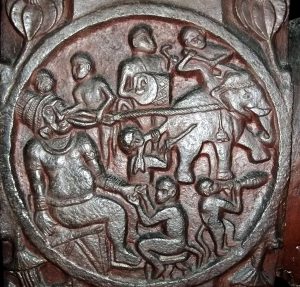
Courtesy- Ken Kawasaki
In Khajuraho temples (885 to 1000 AD) amidst the beautifully carved sensual sculptures, one finds a few sculptures that depict comical situations. In one of the sculptures, a couple, who is trying to get intimate is disturbed by a monkey, who is pulling the walking stick of the man, perhaps to distract him.
Humour is used using utmost economy though. It is never overdone to kill the dominant emotion, which, at Khajuraho, is shringara.
In the Sun temple of Konark, mid-13th century AD, one can see a number of humorous depictions around daily life. These are comical in a culture and time specific manner. Monkeys are shown pilfering sweets from a woman’s basket. Other monkeys are shown trying to get on to the head of the woman in a funny manner. The expressions on the faces of the monkeys are comical. Such scenes, common among the markets of that time must evoke laughter in real-life situations.
The solemn nature of sculptures is interspersed with comical or the humorous, to kill sameness. Humour is usually not related to the religious or mythological theme of the temples, they are found in.
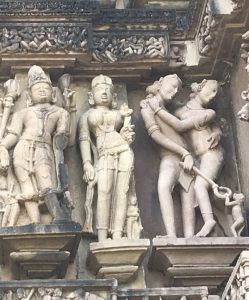
Terracotta, or, the poor man’s sculpture, too, is a great source of social history in India. Their lively naturalism and humour carry a comical strain. One terracotta plaque of the Gupta period, 5th century AD, from Mathura shows a woman playfully pulling the scarf of a court jester (vidushaka). The vidushaka is wearing a conical cap and is making funny gestures. In another plaque, also from Gupta period, the Ganas of Shiva are shown engaged in helping themselves with two basketfuls of sweets, they are shown as nude, corpulent dwarfs with conspicuous genitals. Although it depicts a scene from Daksha yajna of the Mahabharata, this scene has no religious significance. It is of pure fun and frolic intended to amuse simple people. It may have popular appeal for the village folks who might like to recreate such scenes.
Dwarves were also used as a tool to create humour (this was long before body-shaming became a moral crime). At Sanchi, Mathura and Pithalkhora in Andhra, Ellora, Badami Sarnath, Mamallapuram and several other places from 2nd century BC to 9th century AD, dwarves are used as characters signifying different traits. Their imaginative stylisation and expressive exaggeration and quaintness adds comical appeal to the otherwise sombre art of the times.


